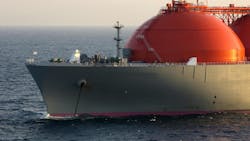LNG trade grew 2.4% in 2024, despite sharp decline in European imports
Global LNG trade grew by 2.4% in 2024 to 411.24 million tonnes, connecting 22 exporting markets with 48 importing markets, according to findings shared in the International Gas Union’s (IGU) ‘2025 World LNG Report.’ Asia Pacific remained the largest exporting region with 138.91 million tonnes in 2024, up 4.10 million tonnes from 2023.
European LNG imports declined sharply, falling 21.22 million tonnes year-on-year to 100.07 million tonnes, according to IGU, driven by high storage levels at the start of the year, sluggish demand, and steady pipeline flows. LNG demand rebounded in Asia, however, with China and India posting strong year-on-year growth in spot imports, driven by heatwaves, infrastructure expansions, and greater reliance on gas for power generation.
Global LNG liquefaction capacity grew by 6.5 million tonnes/year (tpy) in 2024 to a total of 494.4 million tpy by yearend, and only 14.8 million tpy of new liquefaction capacity reached final investment decision, the lowest annual approval volume since 2020 and well below the 58.8 million tpy greenlighted in 2023.
Floating LNG (FLNG) capacity also saw further expansion, with Eni SPA’s 3-million tpy Marine XII FLNG in Republic of the Congo and New Fortress Energy Inc.’s 1.4-million tpy Altamira Fast LNG 1 in Mexico entering operation in 2024. As of early 2025, total operational FLNG capacity stands at 14.35 million tpy.
Menelaos Ydreos, IGU Secretary General, remarked at World Gas Conference 2025 in Beijing, PRC, that “2024 proved to be another vibrant year for the LNG sector's rapid evolution. The trajectory of LNG growth persisted, bolstered by the introduction of two new exporting markets, while global LNG prices have eased compared to prior years. Nonetheless, this market stability remains precarious, highly influenced by significant uncertainties surrounding market and project dynamics, geopolitics, trade, and regulatory policies. Furthermore, the increasing global regulatory focus on methane emissions, particularly from the EU, Japan, and South Korea, is resulting in greater transparency and compliance obligations within the LNG trade.”
